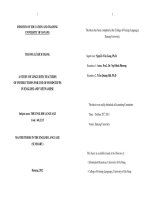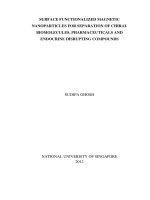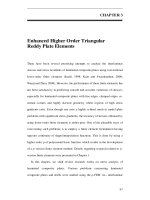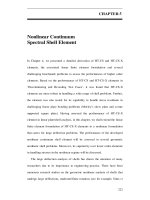Novel membrane sensor for determination of lamotrigine in pharmaceuticals and urine
Bạn đang xem bản rút gọn của tài liệu. Xem và tải ngay bản đầy đủ của tài liệu tại đây (309.57 KB, 10 trang )
Current Chemistry Letters 8 (2019) 87–96
Contents lists available at GrowingScience
Current Chemistry Letters
homepage: www.GrowingScience.com
Novel membrane sensor for determination of lamotrigine in pharmaceuticals and
urine
N. Rajendraprasada*
a
PG Department of Chemistry, JSS College of Arts, Commerce and Science (Autonomous under University of Mysore), B N Road, Mysuru-570 025,
Karnataka, India
CHRONICLE
Article history:
Received July 28, 2018
Received in revised form
February 20, 2019
Accepted February 20, 2019
Available online
February 22, 2019
Keywords:
Membrane sensor
Lamotrigine
Potentiometric determination
Pharmaceuticals
Spiked human urine
ABSTRACT
Lamotrigine (LMT), chemically known as [6-(2,3-dichlorophenyl)-1,2,4-triazine-3,5diamine], is a broad spectrum antiepileptic drug, used as monotherapy and as an adjunct with
other antiepileptic drugs for treatment of partial and generalized toxic-clonic seizures. It is
used to treat neurological lesions and as a tranquilizer. A selective electrochemical membrane
sensor has been developed and validated for determination of LMT. The membrane
constructed using LMT and molybdophosphoric acid in THF and PVC is applicable for the
detection of 5 × 10-4 to 9 × 10-3 M LMT in the pH range between 4.6 and 5.8 with the Nernstian
slope of 57.14±1 mV/decade. The regression coefficient value of 0.9932 showed a good linear
correlation between the concentrations of LMT and measured cell potentials. The limits of
detection (LOD) and quantification (LOQ) values for the fabricated sensor were 1.3 × 10-5 and
4 × 10-5 M LMT, respectively. Various experimental conditions were optimized to reach the
effective performance characteristics of the sensor. The effect of various cations, anions and
organic species on the performance of sensor was studied by following standard-addition
procedure. The results revealed no such variations due to presence of foreign ions or species.
The fabricated sensor was subjected to validation to check accuracy, precision, robustness and
ruggedness. The mean accuracy for determination of LMT was found to be 99.16%. The
developed sensor was successfully used to determine LMT in tablets and in spiked human
urine.
© 2019 by the authors; licensee Growing Science, Canada.
1. Introduction
Lamotrigine (LMT) is chemically known as 3,5-diamino-6-(2,3-dichlorophenyl)-as-triazine (Fig.
1), is an anticonvulsant drug used in the treatment of epilepsy and bipolar disorder. It is also used offlabel as an adjunct in treating clinical depression.
Fig. 1. Chemical structure of LMT
* Corresponding author. Tel: +91 9880547493
E-mail address: (N. Rajendraprasad)
© 2019 by the authors; licensee Growing Science, Canada
doi: 10.5267/j.ccl.2019.002.002
88
As an antiepileptic drug LMT is attracted by many analysts. The monograph in the United States
Pharmacoepia (USP)1 described a chromatographic procedure for determination of LMT using
monobasic potassium phosphate buffer, triethylamine and acetonitrile as mobile phase. The drug LMT
in body-fluids was analysed by various researchers utilizing variety of chromatographic techniques2-17.
Various methods have been reported for its determination in pharmaceuticals and they are titrimetry
with acetous perchloric acid in anhydrous acetic acid medium18, visible spectrophotometry19-21, UVspectrophotometry22, planar chromatography2, thin layer chromatography23, high performance liquid
chromatography24-25, ultra performance liquid chromatography26 and adsorptive stripping
voltammetry27. Two types of LMT ion-selective electrode is reported by Gupta et al. 28. These
electrodes are based on PVC membranes doped with LMT-tetraphenyl borate (TPB) or LMTphosphotungstic acid (PT) ion-pair complexes as molecular recognition materials. The electrodes are
used for determination of LMT in urine and plasma. There is also a report for LMT determination using
molecularly imprinted polymers29 using methacrylic acid as the functional monomer, ethylene glycol
dimethacrylate as crosslinker, 2,2’-azo-bis-iso-butyronitrile as the initiator in 4:3 (v/v) tetrahydrofuran
and acetonitrile. The method is applicable to determine LMT over the concentration range from 1×106
to 1×10-3 M in its pure state and in real samples. Though the reported procedures are specific to
determine LMT, they failed to present outcomes of detailed validation aspects.
Research in the field of development of potentiometric sensors is gaining more and more attention
and a number of potentiometric sensors have been developed for the determination of species in the
areas of chemical, pharmaceutical and biomedical analyses30-41. Potentiometric sensors have extensive
applications to quantify the compounds since they neither require sophisticated instrument nor relying
on stringent experimental conditions. Therefore, an attempt is made to develop a novel potentiometric
membrane sensor for the determination of LMT in pharmaceuticals and spiked human urine. The
membrane sensor is fabricated by preparing the ion pair complex of LMT with molybdophosphoric
acid and its membrane with polyvinyl chloride in THF. Different parameters are optimized to improve
the selectivity of membrane for accurate and precise determination of LMT. The fabricated sensor is
used to determine LMT in pharmaceuticals and spiked human urine.
2. Experimental
2.1. Apparatus
A digital dual channel potentiometer (PICO Ltd., Chennai, India), Ag/AgCl reference electrode and
copper wire were used for potential measurements.
2.2. Materials and methods
The chemicals and reagents used were of analytical grade. Distilled water was used throughout the
work. The pure LMT (99.8%) was kindly provided by Torrent Pharmaceuticals Ltd (Mumbai, India).
Lamitor-DT tablets (100mg LMT/tablet) (Indrad-382721, Mehsana, India) were purchased from local
commercial sources. Dodeca-molybdophosphoric acid (PMA), tetrahydrofuran (THF) and polyvinyl
chloride (PVC) were supplied by S. D. Fine Chem Ltd, Mumbai, India. Concentrated sulphuric acid
(H2SO4) (98% v/v, Sp. gr. 1.84) was supplied by Merck, Mumbai, India. Urine sample was collected
from a 21 year male healthy volunteer, it was filtered and diluted ten times with water before use.
A 0.1 M solution of H2SO4 was prepared by diluting suitable volume of concentrated H2SO4 with
water. A 0.01 M PMA solution was prepared by dissolving calculated amount the compound in distilled
water. Solutions of 1mM each of Na2CO3, NaHCO3, NaOH, CH3COOH, CH3COONH4, KSCN,
sucrose, fructose, glucose, maltose, starch, lactose, glycine, sodium fluoride, calcium chloride, nickel
chloride, potassium chloride, ammonium chloride, cadmium chloride and cobalt chloride were prepared
N. Rajendraprasad / Current Chemistry Letters 8 (2019)
89
by dissolving required weight of the respective compound (all from S.D. Fine Chem Ltd., Mumbai,
India) in distilled water.
2.3. Preparation standard LMT solution
A standard solution of 0.01M LMT was prepared by accurately dissolving calculated quantity of
pure drug in 100 mL of 0.1M H2SO4 in a volumetric flask.
2.4. PROCEDURE
2.4.1. Fabrication of the sensor
A mixture of 20 mL of each of 0.01M solutions of LMT and PMA was stirred for 20 minutes and the
resulted precipitate was collected on Whatmann No. 41 filter paper by filtration. The precipitate was
dried overnight at room temperature. A 20 mg of dried precipitate was taken in a Petri Dish of 4 cm
width, about 0.1g of PVC and 10ml of THF were added. The content after mixing was allowed to
evaporate under room temperature for 24 hours. The dried membrane was fused to one end of nonconducting glass tube with the aid of THF. The dried tube was filled by 3-5 mL internal solution of
0.01M LMT. A pure copper wire of 2.0 mm diameter and 15 cm length was tightly insulated leaving
1.0 cm at one end and 0.5 cm at other end for connection. One terminal of the wire was inserted into
internal solution and the other terminal was connected to the potentiometer. The sensor was conditioned
by soaking in analyte solution for 6 hours.
2.4.2. Preparation of calibration curve
Into a series of 10.0ml volumetric flasks varying aliquots (0.0, 0.5, 1.0, 1.5, 3.0, 4.5, 6.0, 7.5 and 9.0
ml) of 0.01M standard LMT solutions were placed with the help of a microburet. The volume of each
flask was adjusted to 10 mL with water. The potential of each solution was measured by using LMTPMA sensor versus Ag/AgCl reference electrode.
The calibration graph of measured potential versus –log [LMT] was prepared. The concentration
of the unknown was found by using calibration graph or regression equation derived using potential
and –log [LMT] data.
2.4.3. Procedure for interference study
In a 10 ml volumetric flask, 2 ml of 0.01M drug solution and 2ml of 1mM solution of interferent
were taken. The solution after adjusting to pH 5 and diluting to the mark, the potentials of each were
measured using the electrochemical cell assembled for preparation of calibration curve.
2.4.4. Procedure for tablets
Twenty tablets were weighed and transferred in to a clean dry mortar and powdered. Portion of the
tablet powder equivalent to 64.02 mg of LMT was transferred in to a 25 ml volumetric flask and shaken
with 20 ml of 0.1M H2SO4 for 20 minutes. The content was diluted to the mark with the same solvent,
mixed well and filtered through Whatmann No. 41 filter paper. A suitable aliquot was taken and its
potential measured by following the procedure described for preparation of calibration curve. The
concentration of LMT was calculated using the calibration curve or regression data.
2.4.5. Procedure for spiked human urine
In a 10ml volumetric flask 1ml of 1:10 urine and 2ml of 0.01M LMT solution were taken. The
volume was brought to the mark with water and mixed well. After bringing the solution to the optimum
pH of 5 the potential of the solution was measured using LMT-PMA sensor and Ag-AgCl reference
electrode. The concentration of LMT in the solution was calculated using the calibration curve or
regression data.
90
3. Results and discussion
The development and validation of ion-selective electrodes using membranes is of great interest for
pharmaceutical analysis because they offer the advantages of simplicity of fabrication and operation,
rapid response time, fair detection limits, acceptable selectivity, accuracy and precision, applicable to
the detection of wider concentration range of species in coloured and turbid solutions, and probability
to automate and computerize.
The membrane was prepared based on the reaction between aqueous cationic LMT with the solution
of dodeca-molybdophosphate (PMA) to form a stable 1:1 water insoluble ion association complex, with
low solubility product and suitable grain size precipitate. The probable reaction scheme for the
formation of LMT-PMA ion-association complex is given in scheme 1. The formed ion-associate of
LMT-PMA was used to fabricate the membrane consisting with poly-vinyl chloride (PVC) using
tetrahydrofuran (THF).
Cl
Cl
Cl
Cl
+
H2N
O O
-
N
O
N
+
N
HO
Mo P
N
OH
+
LMT in H2SO4
O
N
O OH
NH2
PMA
H3 N
O O
-
N
HO
Mo P
OH
O OH
NH2
LMT-PMA Ion-association complex
Scheme 1. Reaction pathway for formation of LMT- PMA ion-pair complex
The following systematic representation is depicted for the electrochemical cell assembly:
AgCl Reference electrode║ LMT-PMA Sensor│0.01M LMT solution│Cu-Wire
3.1 Optimization of variables
Different experimental variables such as pH, soaking time, response time, stability and effect of
interferents were optimized by measuring the potential of the LMT solution of known concentration
using the developed sensor.
The optimum pH range of the sensor was found to be from 4.6 to 5.8 and between which the
potential measured for each solution of LMT of any concentration within the linear range were almost
constant. There were lower potential values observed at pH lesser than 4.6 and 5.8 (Fig. 2).
200
180
160
140
120
100
80
60
40
20
EMF, mV
EMF, mV
The soaking time was examined by immersing the sensor into a solution of LMT of known
concentration for different time periods. From a series of investigations it was found that the average
soaking time for the conditioning of the electrode is 6 hours (Fig. 3). Therefore, it was found necessary
for the sensor to soak in standard analytic solution at least for 6 hours prior to its use for analyses.
0
1
2
3
4
5
6
7
8
9
pH
Fig. 2. Effect of pH on EMF (1.0 × 10-3 M LMT)
200
180
160
140
120
100
80
60
40
20
B
0
2
4
6
8
10
Time, h
Fig. 3. Effect of soaking time on EMF (1.0 ×
10-3 M LMT)
N. Rajendraprasad / Current Chemistry Letters 8 (2019)
91
After immersing the LMT-PMA sensor along with the reference electrode into the solution of
analyte or containing analyte reproducible and constant potential readings were observed in less than 5
seconds (Fig. 4). Therefore, the response time of the sensor was found as 5 seconds.
The developed sensor was subjected to measure the potential of LMT solution in the presence of
various organic and inorganic compounds, cations and anions as interferents. The study was undertaken
by separately spiking the solutions of 1mM each of intereferent into a 1.0 × 10-3 M LMT solution. This
was done in accordance to the IUPAC guidelines42, 43. None of the added species affected the potential.
This confirmed that the sensor is selective for the determination of LMT in the presence of such charged
or neutral species.
180
170
EMF, mV
EMF, mV
175
165
160
155
150
5
6
7
8
9
10
Time, s
200
190
180
170
160
150
140
130
120
110
3.4
3.2
3.0
2.8
2.6
2.4
2.2
2.0
-log[LMT]
Fig. 4. Study of response time (1.0 × 10-3 M LMT)
Fig. 5. Calibration graph
3.2. Method validation
The electrochemical response parameters of developed LMT-PMA sensor were evaluated
according to IUPAC recommendations42, 43. The data obtained are summarized in table 1. The results
showed that the sensor provides rapid, stable and linear response for the LMT concentration ranged
from 5 × 10-4 to 9 × 10-3 M. The calibration graph (Fig. 5) obtained was linear with Nernestian slope
of 57.14±1 mV/decade. Stable potentiometric readings were obtained with variations within ±1 mV for
the span period of more than a month. The lower limit of detection, calculated from the intercept of the
two lines of the calibration graph, is 1.3 × 10-5 M. The other electrochemical features of the sensor have
also been presented in Table 1.
Table 1. Electrochemical characteristics of the LMT-PMA sensor
Parameters
Linear range, M
Limit of detection (LOD), M
Limit of quantification (LOQ), M
Slope (m), mV/decade
Intercept (b), mV
Correlation coefficient (r)
Response time, s
Working pH range
Life span of sensor, days
Values
5 × 10-4 - 9 × 10-3
1.3 × 10-5
4.0 × 10-5
57.14±1
1.7550
0.9932
<5
4.6-5.8
>30
3.2.1 Accuracy and precision
Accuracy and intra- and inter-day precision were evaluated by analysing pure LMT solutions at
three different concentrations in seven replicates during the same day and five replicates during
different days. The amount of LMT found was calculated for each measurement. The RE (%) and the
RSD (%) values were calculated. The percent relative error which is an index of accuracy is ≤4.50 and
92
is indicative of acceptable accuracy. The obtained RSD values ranged between 2.11 and 4.34%
indicated that the results are prcise enough. The results of this study are presented in Table 2.
Table 2. Results of accuracy and precision study
LMT
taken,
mmol L-1
3.00
6.00
9.00
Intra-day (n = 7)
Inter-day (n = 5)
LMT
found,
mmol L-1
%
RE
%
RSD
3.05
5.73
9.24
1.67
4.50
2.67
2.11
2.42
2.39
LMT
found,
mmol L-1
3.03
5.84
8.76
%
RE
%
RSD
1.00
2.67
2.67
2.45
4.34
2.36
RE: Relative error; RSD: Relative standard deviation.
3.2.2 Robustness and ruggedness
The robustness of an analytical procedure is a measure of its capacity to remain unaffected by small,
but deliberate variations in experimental parameters and provides an indication of its reliability for
normal usage. Under deliberately varied experimental conditions [pH: 4.6(±2) – 5.8(±2) and
temperature: 25±2 ᴼC] the %RSD values ranged from 1.11 to 2.12% revealed robustness. In method
ruggedness, the analyses with different potentiometers, on different days by different analysts were
performed. Such variations did not yield any appreciable changes in the measurement. The interinstrumental and inter-analysts RSD values of <3.4% declared that the proposed potentiometric sensor
is robust enough. The results of robustness and ruggedness studies are presented in Table 3.
Table 3. Results of method robustness and ruggedness study, expressed as %RSD
Robustness
LMT
taken,
M
Alteration of pH
3.00
6.00
9.00
2.12
1.11
1.94
Alteration of
Temperature
1.92
1.99
1.20
Ruggedness
Inter-analysts’
(n=3)
1.89
1.62
1.90
Inter-instruments’
(n=3)
1.32
1.87
1.63
3.2.3 Application to tablets
A 5 mL of 0.01M LMT solution of tablets extract prepared under ‘procedure for tablets’ was
subjected to analysis by the optimized procedure. The mean measured potential for the tablets extract
was found as same as that obtained for the pure drug solution. The results in this study were compared
with those of a reference method1. The reference method is a chromatographic method and in which
LMT is quantified using a mixture of monobasic potassium phosphate buffer, triethylamine and
acetonitrile as mobile phase. The accuracy and precision were evaluated by applying Student’s t- test
and variance ratio F- test, respectively. The calculated t- and F- values at 95% confidence level did not
exceed the tabulated values and this confirmed insignificant difference between the results of reference
and proposed methods. The mean percent recovery of LMT from tablets was found to be 98.9 with
RSD value of 3.2%. These results are presented in Table 4.
Table 4. Results of analysis of tablets by the proposed method and statistical comparison of the
results with the reference method
a
Tablet
analyzed
Label claim,
mg/tableta
Lamitor-DT
100
Foundb (Percent of label claim ±SD)
Reference
method
Proposed method
99.67±1.76
98.90±1.56
t = 0.73
F = 1.27
Amount in mg per tablet; bmean value of 5 determinations.
N. Rajendraprasad / Current Chemistry Letters 8 (2019)
93
3.2.4 Recovery study
A standard addition procedure was followed to further assure the accuracy of the sensor. The solutions
were prepared by spiking pure drug into a pre-analyzed tablet extract at three different levels and
potentials measured using the sensor. To a 2 mL of 0.01M LMT tablets extract, 1, 2 and 3 mL of 0.01
M pure LMT drug solutions were spiked (five replicates), and pH was adjusted. After diluting the
solutions to 10 mL, the potentials of each were measured and the amounts of LMT calculated. The
recovery of pure LMT was computed. The percentage recovery of LMT from tablets, presented in Table
5, ranged from 98.33 to 102.4% revealed that the sensor is selective to give satisfactory in the presence
of excipients.
Table 5. Results of accuracy assessment by recovery test for Lamitor-DT tablets
LMT in
tablet,
mmol L-1
3.01
3.01
3.01
Pure
LMT
added,
mmol L-1
1.50
3.00
4.50
Total
found,
mmol L-1
Pure LMT
recovered
(Percent±SD*)
4.54
5.96
7.62
102.0±1.23
98.33±0.66
102.4±1.18
*Mean value of three measurements
3.2.5 Spiked human urine analysis
From the analysis of spiked human urine sample the percent recovery of LMT were ranged from
93.6 to 98.6% with RSD of <5% indicated that the endogenous substances did not interfere to the assay
and hence the sensor is suitable for its use in physiotherapeutic administration of LMT.
4. Conclusions
This is the first paper describing the fabrication of membrane sensor using phosphomolybdic acid
and its application to determine lamotragine in pharmaceuticals and spiked human urine. The sensor
provides fast and linear Nernestian response over a wide range of lamotragine concentration. The sensor
has been successfully used to determine drug content in pure state, tablets and spiked human urine with
acceptable recovery. The results obtained were accurate and precise with good agreement to consider
the sensor for its use as a tool to determine lamotragine in quality control laboratories. The
electrochemical cell’s assembly is a simple, low cost and selective tool for direct determination of
lamotragine in aqueous media without involving any tedious extraction step.
Acknowledgement
Author thanks Torrent Pharmaceuticals Ltd., Mumbai, India, for gifting pure lamotrigine sample.
The author is indebted to UGC, SWRO, Bengaluru, India, for financial assistance in the form of Minor
Research Project Grant of Award No. 1495-MRP/14-15/KAMY013/UGC-SWRO, dated 04-02-15, to
pursue this research work. The author is grateful to the Principal of JSS College of Arts, Commerce
and Science, B N Road, Mysuru, India, for providing the facilities to pursue this work.
References
1. The United States Pharmacopoeia, XXIV rev, National Formulary XIX Rockville, USP
Convention, USA, 2000.
2. Dreassi, E., Corbini, G.P., Corti, M., Ulivelli, Rocchi R. (1996). Quantitative analysis of
lamotrigine in plasma and tablets by planar chromatography and comparison with liquid
chromatography and UV spectrophotometry. J. AOAC. Intl., 79(6), 1277.
94
3. Contin, M., Balboni, M., Callegati, E., Candela, C., Albani, F., Riva, R., Baruzzi, A. (2005).
Simultaneous liquid chromatographic determination of lamotrigine, oxcarbazepine
monohydroxy derivative and felbamate in plasma of patients with epilepsy. J. Chromatogr. B.,
828(1-2), 113.
4. Sean, R., Scheuer., Mark L. (1998). Determination of lamotrigine in biologic materials by a
simple and rapid liquid chromatographic method. Ther. Drug. Monit., 20(2), 209.
5. Matar, K.M., Nicholls, P.J., Bawazir, S.A., Al-Hassan, M.I., Tekle, A. (1999). Liquid
chromatographic determination of six antiepileptic drugs and two metabolites in microsamples
of human plasma. Ther. Drug. Monit., 21(5), 559.
6. Cheng, C.L., Chou, C.H., Hu, O.Y. (2005). Determination of lamotrigine in small volumes of
plasma by high-performance liquid chromatography. J. Chromatogr. B., , 817(2), 199-206.
7. Matar, K.M., Nicholls, P.J., Bawazir, S.A., Al-Hassan, M.I., Tekle, A. (1998). A rapid liquid
chromatographic method for the determination of lamotrigine in plasma. J. Pharm. Biomed.
Anal., 17(3), 525.
8. Londero, D., Lo Greco. (1997). New micromethod for the determination of lamotrigine in
human plasma by high-performance liquid chromatography. J. Chromatogr. B. Biomed. Sci.
Appl., 691(1), 139.
9. Elizabeth, G.S., Lower, D.R., Virji, M.A., Krasowski, M.D. (2007). Simultaneous
determination of lamotrigine, zonisamide, and carbamazepine in human plasma by highperformance liquid chromatography. Biomed. Chromatogr., 21(3), 225.
10. Patil, K.M., Bodhankar, S.L. (2005). Simultaneous determination of lamotrigine,
phenobarbitone, carbamazepine and phenytoin in human serum by high-performance liquid
chromatography. J. Pharm. Biomed. Anal., 39(1-2), 181.
11. Saracino, A.P., Maria, A.M., Koukopoulos, G.M., Sani, M.M.A., Raggi, M.A. (2007).
Simultaneous high-performance liquid chromatographic determination of olanzapine and
lamotrigine in plasma of bipolar patients. Ther. Drug. Monit., 29(6), 773.
12. Bartoli, A., Marchiselli, R., Gatti, G. (1997). A rapid and specific assay for the determination
of lamotrigine in human plasma by normal-phase HPLC. Ther. Drug. Monit., 19(1), 100.
13. Cociglio, M., Alric, R., Bouvier, O. (1991). Performance analysis of a reversed-phase liquid
chromatographic assay of lamotrigine in plasma using solvent-demixing extraction. J.
Chromatogr.B: Biomed. Sci. Appl., 110 (1), 269.
14. Lensmeyer, G.L., Gidal, B.E., Wiebe, D.A. (1997). Optimized high-performance liquid
chromatographic method for determination of lamotrigine in serum with concomitant
determination of phenytoin, carbamazepine, and carbamazepine epoxide. Ther. Drug Monit.,
19(1), 292.
15. Angelis-Stoforidis, P., Morgan, D.J., O’Brien, T.J., Vajda, F.J.E. (1999). Determination of
lamotrigine in human plasma by high-performance liquid chromatography. J. Chromatogr. B.
Biomed. Sci. Appl., , 727(1), 113.
16. Croci, D., Salmaggi, A., de Grazia, U., Bernardi, G. (2001). New high-performance liquid
chromatographic method for plasma/serum analysis of lamotrigine. Ther. Drug. Monit., , 23(6),
665.
17. Castel-BrancoAlmeida, A.M., Falcao, A.C., Macedo, T.A., Caramona, M.M., Lopez, F.G.
(2001). Lamotrigine analysis in blood and brain by high-performance liquid chromatography.
J. Chromatogr. B. Biomed. Appl., 755(1), 119.
18. Rajendra Prasad, N., Basavaiah, K., Vinay, K.B. (2009). Determination of drug content of
pharmaceuticals containing Lamotrigine by titrimetry in non-aqueous medium. Proc. Indian
Nat. Sci. Acad., 75(3), 131.
19. Rajendra Prasad, N., Basavaiah, K., Vinay, K.B. (2010). Sensitive spectrophotometric
determination of lamotrigine in bulk drug and pharmaceutical formulations using bromocresol
green. Ecl. Quim., 35(1), 55.
N. Rajendraprasad / Current Chemistry Letters 8 (2019)
95
20. Rajendra Prasad, N., Basavaiah, K., Vinay, K.B. (2010). Micro and nanogram determination of
lamotrigine in pharmaceuticals by visible spectrophotometry using bromophenol blue. Indian
J. Chem. Tech., 17(5), 220.
21. Alizadeh, N., Khakinahad, R., Jabbari, A. (2008). Spectrophotometric determination of
lamotrigine in pharmaceutical preparations and urine by charge-transfer complexation.
Pharmazie., 63(11), 791.
22. Talekar, R.S., Dhake, A.S., Sonaje, D.B., Mourya, V.K. (2000). Spectrophotometric
determination of lamotrigine. Indian J. Pharm. Sci., 62(1), 51.
23. Youssef ,N.F., Taha, E.A. (2007). Development and validation of spectrophotometric, TLC and
HPLC methods for the determination of lamotrigine in presence of its impurity. Chem. Pharm.
Bull., 55(4), 541.
24. Elizabeth, G-S., Giannoutsos, S., Lower, D.R., Virji, M.A., Krasowski, M.D. (2007). Drug
monitoring: simultaneous analysis of lamotrigine, oxcarbazepine, 10-hydroxycarbazepine, and
zonisamide by HPLC-UV and a rapid GC method using a nitrogen-phosphorus detector for
levetiracetam. J. Chromatogr. Sci., 45( 9), 616.
25. Anantha Kumar, D., Venkata Kumar, C., Seetharamaiah, P., Sheshagiri Rao, J.V.L.N. (2010).
Estimation of lamotrigine by RP-HPLC method. J. Chem., 7(S1), S203.
26. Vinay, K. B., Revanasiddappa, H. D., Cijo1, M. X., Ramesh, J., Swamy, N., Rajendraprasad,
N. (2015). Stability indicating ultra performance liquid chromatographic assay of lamotrigine
in pharmaceuticals. Trakia J. Sci., 13(1), 1.
27. Olga, D.R., Calvo, M.E., Acros-Martinez, M.J. (2008). Determination of lamotrigine in
pharmaceutical preparations by adsorptive stripping voltammetry using screen printed
electrodes. Sensors, 8(12), 4201.
28. Gupta, V. K., Singh, A. K., Gupta, B. (2007). Development of membrane electrodes for
selective determination of some antiepileptic drugs in pharmaceuticals, plasma and urine. Anal.
Bioanal. Chem., 389, 2019.
29. Hayedeh B.S., Soltan A. E., Atefeh T., Fatemeh B., Hadi A., Nasim A., Somayeh M. (2011).
Potentiometric Sensing of Lamotrigine Based on Molecularly Imprinted Polymers. Electroanal.
23(11), 2716 .
30. Ensafi, A., Allafchian, A. R. (2008). Potentiometric sensor for betahistine determination in
pharmaceuticals, urine and blood serum. J. Pharm. Biomed. Anal., 47(4-5), 802.
31. Kanberoglu, G. S., Coldur, F., Topcu, C., Cubuk, O. (2015). PVC-Membrane Potentiometric
Sensor for the Determination of Tamoxifen in Pharmaceutical Formulations. IEEE Sensors
J., 15(11), 6199.
32. AlRabiah, H., Al-Majed, A., Abounassif, M., Mostaf, G.A.E. (2016). Two novel potentiometric
sensors for determination of clonidine in some pharmaceutical formulation. Int. J. Electrochem.
Sci., 11, 6761.
33. Ganjali, M.R., Karimi, S., Shahtaheri, S.J., Norouzi, (2013). Determination of clonidine by
potentiometry using PVC membrane electrode. Int. J. Electrochem. Sci., 8, 1999.
34. Del Valle, E.M. (2004). Cyclodextrins and their uses: a review. Process Biochem., 39, 1033.
35. Hedges, A.R. (1998). Industrial Applications of Cyclodextrins. Chem. Rev., 98, 2035.
36. Yang, R., Li, K.A., Wang, K., Zhao, F., Li, N., Liu, F. (2003). Porphyrin assembly on βcyclodextrin for selective sensing and detection of a zinc ion based on the dual emission
fluorescence ratio. Anal. Chem., 75, 612.
37. El-Kosasy, A.M., Nebsen, M., El-Rahman, M.K.A., Salem, M.Y., El-Bardicy, M.G. (2011).
Comparative study of 2-hydroxy propyl beta cyclodextrin and calixarene as ionophores in
potentiometric ion-selective electrodes for neostigmine bromide. Talanta, 85, 913.
38. Trojanowicz, M. (2014). Enantioselective electrochemical sensors and biosensors: A minireview. Electrochem. Comm., 38, 47.
39. Patil, S.R., Turmine, M., Peyre, V., Durand, G., Pucci, B. (2007). Study of βcyclodextrin/fluorinated trimethyl ammonium bromide surfactant inclusion complex by
fluorinated surfactant ion selective electrode. Talanta, 74, 72.
96
40. El-Kosasy, A.M. (2003). Determination of hydroxyurea in capsules and biological fluids by
ion-selective potentiometry and fluorimetry. J. AOAC Intl., 86, 15.
41. Ozoemena, K.I., Stefan, R-I. (2005). Enantioselective potentiometric electrodes based on alpha, beta-, and gamma-cyclodextrins as chiral selectors for the assay of l-proline. Talanta, 66, 501.
42. IUPAC Analytical Chemistry Division, Recommendation for Nomenclature of Ion Selective
Electrode. Pure Appl. Chem., 1994, 66, 2527.
43. IUPAC Analytical Chemistry Division, Potentiometric selectivity coefficients of ion selective
electrodes. Pure Appl. Chem., 2000, 72, 1851.
© 2019 by the authors; licensee Growing Science, Canada. This is an open access
article distributed under the terms and conditions of the Creative Commons Attribution
(CC-BY) license ( />









